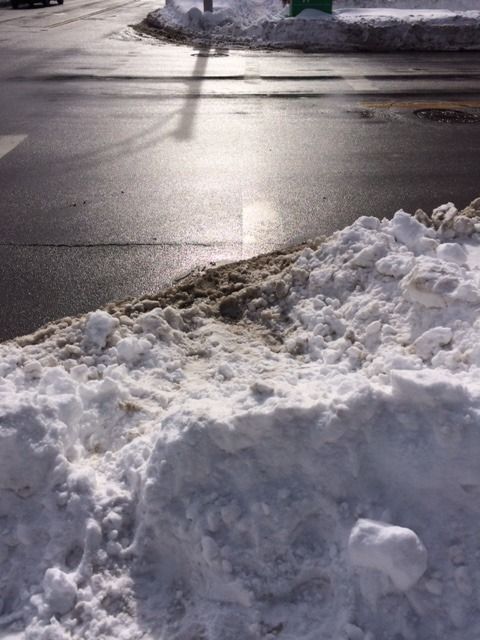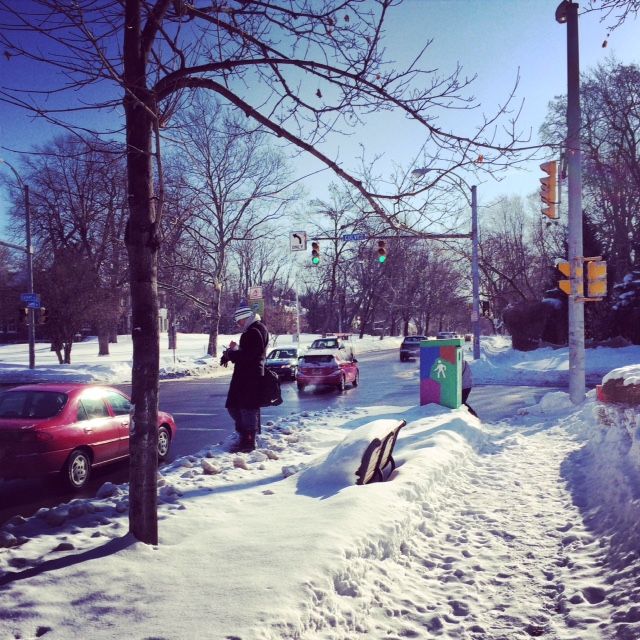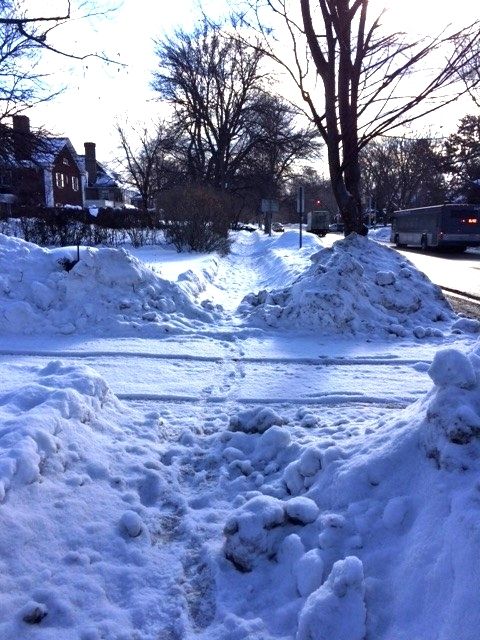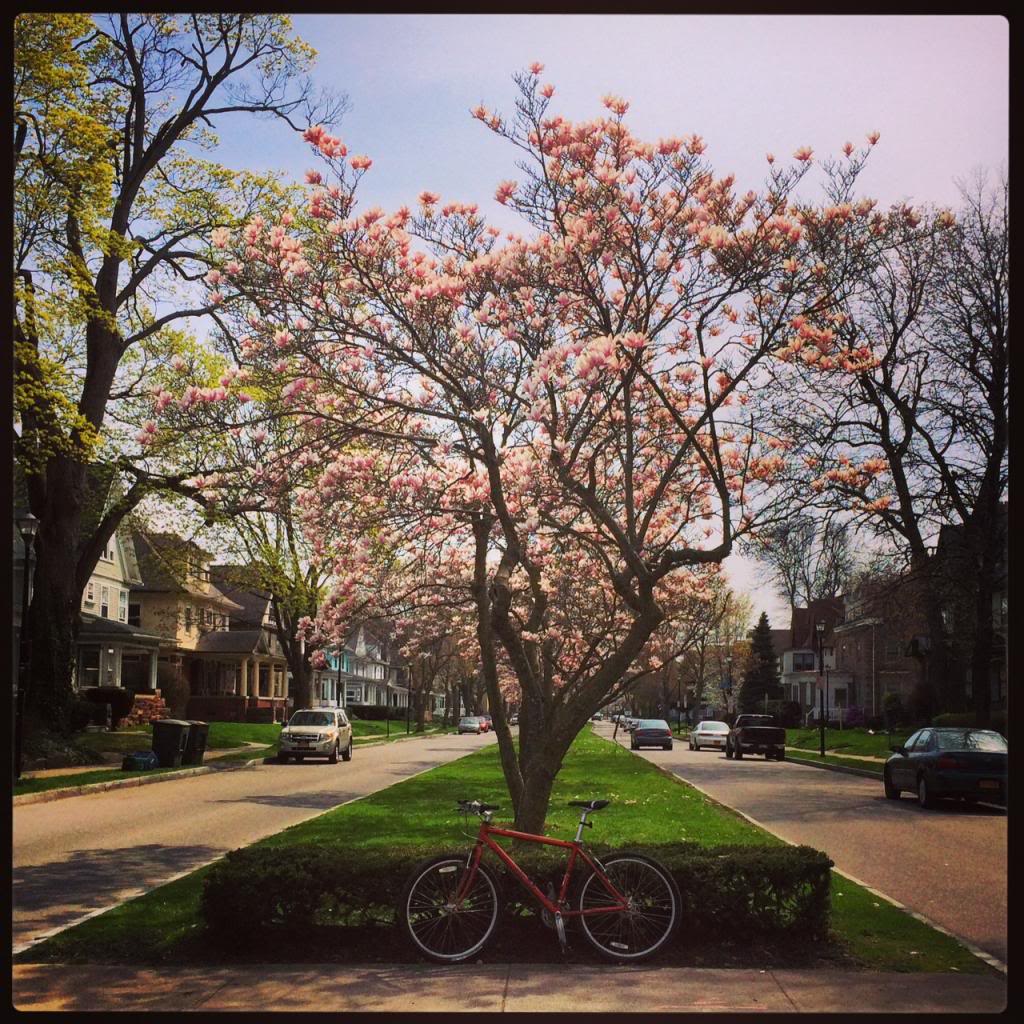The picture at left is of my walk to work this morning. I warm up my ankles before I walk out the door, and take my snowboarder’s arm stance the entire way there just in case I fall. We haven’t had much snow this week compared to other weeks, so the sidewalks should be clearer by now.
 And below is the intersection of Culver and University, where there are people walking to and from the bus stop, as well as the stores and restaurants on University and Park. The streets are beautifully clear, yet this is what you have to walk over as a pedestrian to cross the street. Someone with a stroller, cane, wheelchair or with less than agile legs would find it impossible. They would, instead, opt for the clear street.
And below is the intersection of Culver and University, where there are people walking to and from the bus stop, as well as the stores and restaurants on University and Park. The streets are beautifully clear, yet this is what you have to walk over as a pedestrian to cross the street. Someone with a stroller, cane, wheelchair or with less than agile legs would find it impossible. They would, instead, opt for the clear street.
A common comment I see from drivers on various media and blog posts about unplowed/unshoveled sidewalks complain about “all the people walking in the street.” “I shovel and people still walk in the street.” Well, when the streets are plowed and clear and the sidewalks aren’t, it’s often the only safest path.
I see an older couple frequently walking on Culver with one of those grocery carriers with wheels heading to Price Rite. And impatient drivers honk and swerve. But with the conditions of the sidewalk, they have decided it is more dangerous to walk on the bumpy icy unpredictable sidewalk than on the street where the path is clear. I see lots of people on East Avenue toward Alexander having to walk in the street right now too (and I don’t see that when sidewalks are clear).
When I posted about sidewalks recently, a colleague of mine at Reconnect Rochester who is an avid year-round cyclist and walker, said the attention paid to those not driving cars this winter does not bode well for reducing car dependency in our area. People who might ordinarily walk, take the bus and/or bike will likely throw in the towel and buy a car. Those who can’t drive or afford a car, will continue to be forced to walk in the street.
Those of us who walk (by choice or necessity) are earning our stripes this winter. Check out the guy in the photo below towering over the cars waiting for a bus. Crappy weather and yellow snow are expected around this place in winter. But safe pedestrian pathways shouldn’t have to be part of the winter fight.
Has this winter changed your mind about how you plan to get about the city next winter?

8 Comments
-
Great article Renee. In addition to the frozen mess on the sidewalks, the vast majority of bus stops are buried under a wall of snow. The bottom line is that the city needs a new strategy for sidewalks and bus stops. The current strategy only works if we have frequent thaws, and if property owners actually shovel. I have never seen the city make an effort to really get the word out that property owners are responsible for clearing their sidewalks. Has the city ever warned any property owner that they need to shovel, let alone actually fine someone?
The city recently changed the sidewalk plowing contract so that the plows will not go out unless a single snowfall is over 3 inches. Can we just admit that this simply isn’t working?
-
Thanks for the comment, John! I have been thinking that this requires an innovative and collaborative approach to snow removal. But where would the money come from? Is it a matter of allocating the current funds from our property tax fee differently (more efficiently)? Or is it that the fee can’t really cover snow removal on a regular basis? This is my sixth winter here and I remember the first few having clearer sidewalks (and frequent sidewalk plowing).
-
DeWain, I have a whole series of photos of buried bus stops too. A good portion of the pedestrians around town are transit riders, of course. I see people with shopping bags, strollers, etc., standing atop frozen snow drifts, in the street and on the sidewalks (and then have to hike over a huge pile of snow to get on board the bus). It’s a frequent topic in our house. But, again, where will the funds come from to clear the bus stops? I too remember clearer sidewalks our first few winters here. Has the policy changed (it’s 4″ accumulation in one snowfall now)? Or is the process just worse now?
-
John, I really agree with most of your comment, but I would strongly caution about suggesting that volunteers (such as community associations) could make a serious dent in the problem. As a former president of a community association, I can say that most community associations’ volunteer resources are already beyond tapped out. Worse yet, the ability/willingness of residents to volunteer is inversely proportional to degree to which the neighborhood is challenged.
Even worse, we have seen cases where City Hall claimed that problems (specifically code violations) should be addressed by neighborhood volunteers. I firmly believe that the city officials were more motivated to use a “volunteer solution” as a way of ducking responsibility than a sincere attempt at coming up with a solution.
There is some room for collaboration, but for the most part we need more aggressive plowing from the city, much more education of residents and businesses (as to their responsibility for sidewalks), and enforcement.
-
Oh, and DeWain, to answer your earlier question: “Can we just admit that this simply isn’t working?” Yes. It isn’t working. And we should admit it and problem solve as a community.
-
DeWain, agreed about limited neighborhood association person power. I’ve been involved in the Upper Monroe NA for about 30 years and I know how fragile they are, especially those without paid staff. However, I truly believe neighborhood associations are THE future of the City. Without old-fashion citizen action and involvement, our beloved City is dead. Sadly I agree that volunteerism inversely correlates with poverty levels in a neighborhood and this needs to be recognized in any government program.
But to say it is the government’s job, not mine is a fallacy. We are the government and we are the neighborhood association. On the other hand, government should not say it is the citizen’s job, not the government. Partnerships are needed within the limits of the resources of each partner. So when it comes to inadequate sidewalk snow plowing, it will take many partners to solve. ‘nuf said.
-
Hey, I sense a vacuum here–a vacuum of concern for pedestrians (and bikers and transit riders) in winter. And I think Project Reconnect is great at filling vacuums. Let’s give it a try!







I walk over to the Monroe Ave Y and the worst sidewalks are on bridges, especially Interstate bridges. The road is preferable to the sidewalks on these bridges.
But enough of the bitching. What is needed is an Action Plan to deal with sidewalk snowplowing and I suspect it will involve a partnership of City, Transit Authority, property owners, neighborhood associations, and other non-profit groups. It must involve the 3 E’s–enforcement, education, and citizen empowerment.
I heard a town in Wisconsin fines the hell out of property owners (businesses and residents) who don’t shovel their sidewalks. Enforcement of the existing sidewalk snowplowing laws is part of it, perhaps with a media campaign. Sidewalk snowplowing inspections must be tightened (if they exist in the first place). City crews could easily be assigned to bridges since there are relatively few of them. Businesses, neighborhood associations, churches, youth groups, prisoners, retirees, really anyone who can hold a shovel should be recruited for an adopt-a- block system with sidewalks ranked according to pedestrian use.
And while we are at it, why not include shoveling out fire hydrants and bus stops with Transit Authority assistance. And in the summer (yes summer is coming) it could include litter pick-up, catch basin grate cleaning, and bus stop seating. All it takes is some old-fashioned organization and involvement. But do we have the political will to say this is an important public policy to enhance pedestrian (and transit and bicycle) safety and environment? That is the question…..